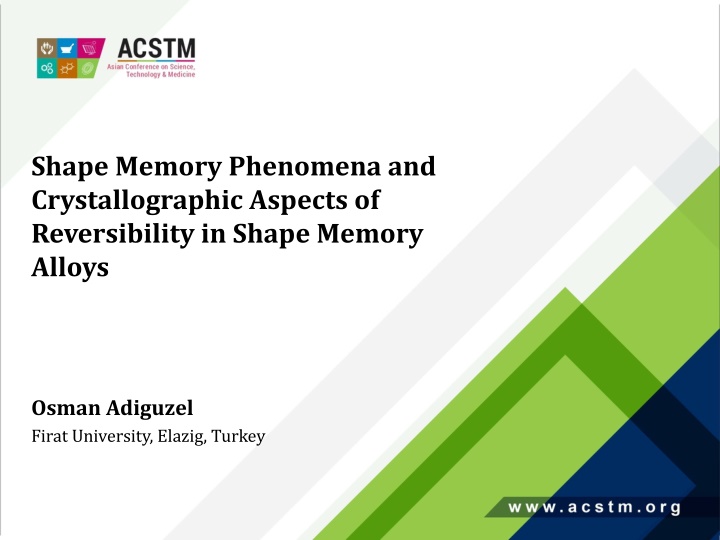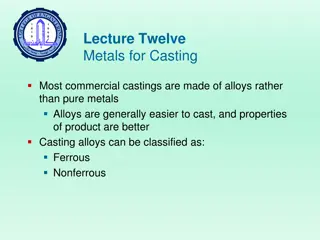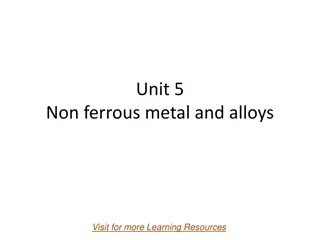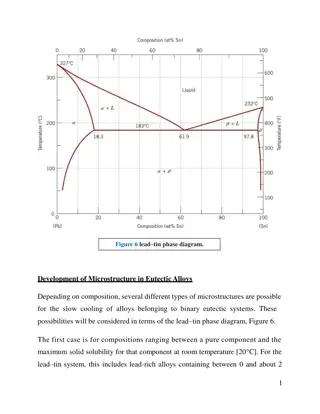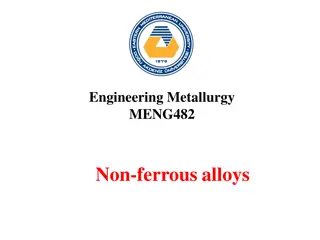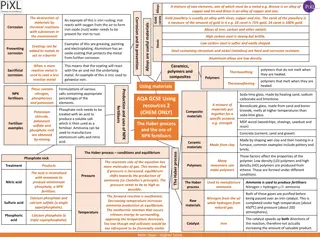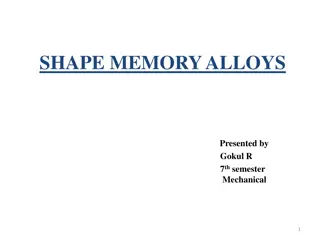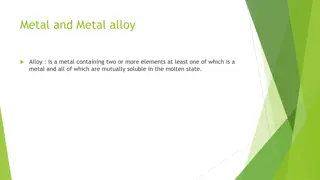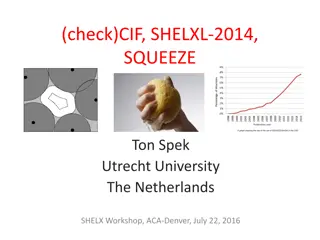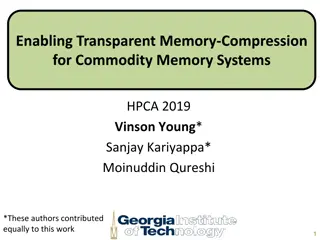Shape Memory Alloys and Reversibility: Crystallographic Aspects
Shape memory alloys exhibit a unique property known as shape memory effect, where the material cycles between original and deformed shapes in a reversible way. This phenomenon is governed by crystallographic transformations, thermal and stress-induced martensitic transformations, and superelasticity. The processing of shape memory effect and superelasticity at the bulk level involves thermal and mechanical memory. Understanding the temperature hysteresis of shape memory alloys is crucial in exploring the intricate phenomena associated with shape memory alloys and superelasticity. Crystallographic transformations and martensitic transformations play key roles in shaping microstructural changes at atomic scale, leading to shape changes at a bulk level induced by internal stresses.
Download Presentation

Please find below an Image/Link to download the presentation.
The content on the website is provided AS IS for your information and personal use only. It may not be sold, licensed, or shared on other websites without obtaining consent from the author.If you encounter any issues during the download, it is possible that the publisher has removed the file from their server.
You are allowed to download the files provided on this website for personal or commercial use, subject to the condition that they are used lawfully. All files are the property of their respective owners.
The content on the website is provided AS IS for your information and personal use only. It may not be sold, licensed, or shared on other websites without obtaining consent from the author.
E N D
Presentation Transcript
Shape Memory Phenomena and Crystallographic Aspects of Reversibility in Shape Memory Alloys Osman Adiguzel Firat University, Elazig, Turkey
Shape Memory Alloys and Shape Memory Effect Shape memory alloys take place in a class of advanced smart materials by exhibiting a peculiar property called shape memory effect. This phenomenon is initiated with thermomechanical treatments on cooling and deformation and performed thermally on heating and cooling, with which shape of the material cycles between original and deformed shapes in reversible way. This phenomenon is governed by the crystallographic transformations, thermal and stress induced martensitic transformations. These alloys exhibit another phenomenon, called superelasticity, which is performed in only mechanical manner with stressing the material and releasing in the parent austenite phase region, and shape recovery occurs instantly upon releasing, by exhibiting elastic material behavior.
Processing of SME and SE in bulk level Thermal and Mechanical Memory Thermal and Mechanical Memory Shape Memory Shape Memory Superelasticity Superelasticity
Shape Memory Effect (SME) and Superelasticity (SE) Shape Memory Effect is governed by crystallographic transformations, thermal and stress induced martensitic transformations and evaluated by the structural changes in atomic scale and crystallographic level. Superelasticity is also result of stress induced martensitic transformation and performed with mechanically stressing and releasing in elasticity limit at a constant temperature in the parent austenite phase region.
Shape Memory Effect (SME) and Superelasticity (SE) Shape Memory Effect is governed by crystallographic transformations, thermal and stress induced martensitic transformations and evaluated by the structural changes in atomic scale and crystallographic level. Superelasticity is also result of stress induced martensitic transformation and performed with mechanically stressing and releasing in elasticity limit at a constant temperature in the parent austenite phase region.
SME, SE and Martensitic Transformations Shape microstructural changes in atomic scale caused by internal stresses, and shape chance occurs in bulk level. Shape memory effect is governed by thermal, and stress induced martensitic transformations. Thermal induced martensitic transformations occur with cooperative movements of atoms by means of lattice invariant shear in <110 > -type directions on the {110} - type planes of austenite matrix and ordered parent phase structures turn into twinned martensite structures. The twinned structures turn into detwinned martensite structures by means of stress induced transformation by stressing the material in the martensitic condition. Superelasticity is also governed by stress induced martensitic transformation and ordered parent phase structures turn into detwinned martensite structure with stressing. memory behaviour is evaluated by the
Schematic of Shape Memory Cycle High symmetric ordered austenite phase structures turn into the twinned structures, martensite variants blue and green), on cooling. Twinned martensite structures turn into the detwinned martensite structure, by means of stress induced martensitic transformation with stressing at low temperature. Detwinned martensite structures revert back to the ordered parent phase structures, by means of reverse austenitic transformation upon heating.
Schematic of Superelasticity Stressing of the material in high temperature parent phase region, parent phase can generate stress-stabilized martensite, which reduces the energy required to accommodate an applied deformation. Material structure turns into the ordered parent phase structure upon removing the stress.
Superelastic behaviour and stress-strain diagram of Superelaticity! Stress-strain curve exhibit non-linear behavior, and stressing and releasing paths are different, and hysteresis loop refers to the energy dissipation.
Basic - phase structures ( a ) Basic bcc ( A2) unit cell, ( b ) CsCl -(B2) type unit cell, ( c ) Cu3Al - ( DO3 ) - type unit cell (half), ( d ) Cu2AlMn - (L21 ) type unit cell (half).
Experimental Alloys 1. CuZnAl (Alloy 1) Cu- 26.1%Zn - 4% Al ( in weight) Cu- 24.2%Zn - 9% Al (in atomic) Ms = 36 C, Mf = 30 C 2. CuAlMn (Alloy 2) Cu- 11.0%Al - 6% Mn ( in weight) Cu- 22.4%Al - 6% Mn ( in atomic) Ms = 133 C, Mf = 98 C Ms , Mf : Martensite start and finish temperatures. Both alloys are fully martensitic at room temperature.
Thermal treatments Specimens obtained from these alloys were solution treated for homogenisation in the -phase field as following and then quenched in iced-brine and aged at room temperature. CuZnAl alloy: at 830 C for 15 minutes and quench in iced-brine. CuAlMn alloy: at 700 C for 20 minutes and quench in iced-brine. Powder specimens Powder specimens for X-ray examination were prepared by filling the alloys. Powder specimens were sealed in evacuated quartz tubes and given -phase homogenisation treatments: CuZnAl alloy: at 830 C for 15 minutes and quench in iced-brine. CuAlMn alloy: at 700 C for 15 minutes and quench in iced-brine. Powder diffractograms were obtained for all the specimens at different stages of ageing in a long time interval.
X-Ray diffractograms 1. CuZnAl Alloy Long-term aging at RT for about fifteen years after quenching 3000 0 0 18 _ 2500 128 208 2000 intensity 1500 1 2 10 1000 _ __ 122 202 2 0 10 500 0 2q 2q 35 40 45 50 55
2. CuAlMn Alloy Long-term aging at RT for about fifteen years after quenching 2000 0 0 18 1500 _ intensity 128 208 1000 _ 1 2 10 122 202 __ 500 2 0 10 0 35 40 45 50 55 2q q
Interplane relations A series of x-ray diffractograms have been taken from both alloy samples in a long-time interval, and some changes have been observed in diffraction angles and peak intensities and characteristics with aging duration. In particular, some of the successive peak pairs have shifted toward each other.These successive peaks provide the following relation: where n=4 for 18R martensite. These plane pairs can be listed as follow for 18R structure; (122)- (202), (128)-(208), (1 2 10) (2 0 10), (040)- (320). At the long term investigation ( nearly 15 years), it is observed that these peak pairs come close each other with aging duration. These changes reveal the changes in the crystal structure of the material.
The effect of atom sizes on basal plane The martensitic phase is based on one of the {110} planes of parent phase. The(110) basal plane which has a rectangular shape in parent phase is subjected to hexagonal distortion and undergoes a hexagon. This process is schematically illustrated below. Atomic configuration of the (110) plane of DO3 - type ordered -matrix (a) before and (b) after hexagonal distortion, (c) principal basal plane axes of the 18R structure. ( a ) ( b ) ( c )
Electron Diffractions Electron Diffractions patterns taken from CuZnAl and CuAlMn alloys also exhibit super-lattice reflection
Conclusions Shape memory effect is evaluated by the structural changes in microscopic scale by means of martensitic transformation. The fundamental structures of the -type martensites are orthorhombic close-packed structures which consist of an array of close-packed planes in copper based SMAs. The -type martensites have the layered structures and are characterized by the stacking sequences depending on the order in parent phase. Copper based ternary alloys have the DO3 - type superlattice in parent austenite phase, and the following stacking sequence occurs with martensitic transformation; AB CB CA CA BA BC BC AC AB (18R). Based on austenite-martensite relation, the basal plane of 9R (or 18R) martensite originates from the {110 -type planes of the parent phase, on which lattice invariant shears occur in the <110>-type directions during the transformation.
References 1. J. Ma, I. Karaman and R.D. Noebe, High Temperature Shape Memory Alloys, International Materials Reviews, 55(5), 257-315 (2010). 2. Dimitris C. Lagoudos (editor), Shape Memory Alloys, Modeling and Engineering Applications, Springer (2008). 3. L. Sun, W.M. Huang, Z. Ding, Y. Zhao, C.C. Wang, H. Purnawali and C. Tang, Materials & Design 33, 577, 2012. 4. K. Otsuka and T. Kakeshita, MRS Bulletin, 27(2), 91-100 (2002). 5. M. A. Rahman, Recent Patents on Mechanical Eng., 1, 65-67 (2008). 6. R. D. James and K. F. Hane, Acta Materialia, 48 (1), 197-222 (2000). 7. L. Sun, W.M. Huang, Z. Ding, Y. Zhao, C.C. Wang, H. Purnawali and C. Tang, Stimulus-responsive shape memory materials: A review, Materials & Design, 33, January 2012, Pages 577 640 8. Y.F. Hsu, W.H. Wang, The stress-induced martensitic transformation and Superelasticity in a Cu Zn alloy containing 1 plates, Materials Characterization 48 (2002), 1 10. 9*. S. Barbarino, et al., Areview on shape memory alloys with applications to morphing aircraft, Smart Mater. Struct. 23 (2014) 063001 (19pp), IOP Publishing
Thank you very much for your attention!
